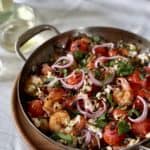
Barrel-aged feta, Cretan Graviera, and whey-made mizithra mix well with seafood in Greece
Photo: Christine Burns Rudalevige
Confident Italians (and their vocal cousins living in other parts of the world) don’t typically explain why they aggressively eschew combining seafood and cheese on the same plate. It just isn’t done. It’s a culinary passo falso (false step).
Food historians, however, posit several reasons for the prohibited pairing. The geographical argument says most of the best Italian cheeses are made in the mountains where dairy herds thrive, not near the sea where fresh fish is daily fare. So traditional Italian recipes using either fish or cheese were developed on parallel tracks rather than intersecting ones. That claim loses ground, though, when one considers regions like Campania, from where Mozzarella di Bufala Campana hails, and Lazio and Sardinia, where pecorino Romano and Pecorino Sardo, respectfully, are made. Those parts of Italy all sport substantial coastlines.
The gustatorial argument says the strong flavor of cheese overwhelms the mild flavor of fish. The counterpoint here is that a lot of seafood (clams, mackerel, mussels, and sardines) packs a potent punch while many Italian cheeses (burrata, ricotta, and provolone dolce) are quite genteel.
The ancient history argument, says California-based food archeologist Farrell Monaco, lies in ancient writers making the pairing a controversial one just as the Romans rose to replace the Greeks as the dominant power in the Mediterranean.
Monaco explains that 300 years or so before the definitive rise of the united Roman empire, when Sicily was an important Greek colony, a Greek-speaking Syracusan cook named Mithaecus brought to Athens aspects of Sicilian gastronomy, elements of which would later be considered the underpinnings of Greek fine dining.
Plato mentions Mithaecus, rather disparagingly, in his fourth century B.C. Socratic dialog Gorgias when he says the cook’s decadent food has no place in a healthy civilization’s diet.
Despite the Platonic critique, Mithaecus penned on sheepskin parchment what is believed to be western civilization’s first complete cookbook. Sadly, only one recipe from that book is known to us now. It uses cheese in the preparation of a ribbon-like fish called tainia. According to Athenaeus, the Greek rhetorician who recounted this recipe in his third century A.D. tome Deipnosophists (loosely translated as Philosophers at Dinner), it went something like this: After you gut a tainia and remove its head, wash it off, cut it into steaks, and pour cheese and olive oil over it.
In another part of Athenaeus’s 15-volume opus, Monaco explains, his dinner philosophers discuss a second fourth century B.C. Greek food writer’s instructions on other ways to pair curds with fish. But from these citations, taken from a poem entitled The Life of Luxury by Archestratus, Monaco says the snark about Sicilian and Syracusan plates of cheesy seafood very clearly details his distaste for them. The repeated practice of criticizing Greek and Sicilian cooks who combined seafood and cheese could in fact be the origin point for the long-standing taboo of the pairing in modern Italian cuisine, according to Monaco.
“Seafood and cheese are paired in Greece, particularly in the coastal port villages and on the islands, because fish is readily available; and many traditional Greek cheeses are simple, fresh, rindless ones created by nomadic shepherds from sheep’s and goat’s milk. Their tangy acidity naturally enhances the flavors of the seafood.”
Still, it’s difficult to discern from these texts which ancients—the Greeks or the Romans—despised
the Sicilian penchant for combining fish and cheese more at that point in time. Fast forward to the twenty-first century, though, and there is plenty of evidence that modern Greek culinary culture has embraced the pairing— even if it’s still not welcome in Rome.
Modern Marriages
“Regarding the cheese and seafood love affair, I believe we all come from a place where we are guided against their pairing,” says Marianna Leivaditaki, a Cretan-born, London-based chef. “The truth, though, is that the two ingredients can go well together and nothing strange happens.”
While corresponding electronically as she visited family in Crete, Leivaditaki said she’d just finished
a meal of beautifully grilled cuttlefish stuffed with fresh Cretan mizithra and literally nothing else. Cretan mizithra is a soft, white, salty, spreadable cheese made by combining whey and fresh, raw goat’s and/or sheep’s milk.
Greek-American chef and cookbook author Diane Kochilas demonstrates how to make a similarly stuffed squid dish in which she combines mild, soft, whey-based anthotiros; nutty, grated sheep’s milk graviera; and salty Greek DOP feta cheeses in an episode of her public television series My Greek Table. Now in its third season, the picturesque travel show focuses on the culture and cuisine of Greece’s coastal areas and many islands.
Will Studd is a British-born Australian cheesemonger who champions artisan cheeses around the world. He’s currently singing the praises of barrel-ripened feta being made by only a handful of small dairies in Greece. This classic Greek feta made from a mix of ewe’s and goat’s milk sits in oak barrels for four to six months, an aging process that yields cheese that is crumbly yet creamy in texture and has a rich, sweet, and tangy flavor. Studd says he likes to crumble it over any type of grilled shellfish.
“Seafood and cheese are paired in Greece, particularly in the coastal port villages and on the islands, because fish is readily available; and many traditional Greek cheeses are simple, fresh, rindless ones created by nomadic shepherds from sheep’s and goat’s milk. Their tangy acidity naturally enhances the flavors of the seafood,” says Studd. Like lemon juice does.
One of Leivaditaki’s favorite seafood and cheese combinations features a fillet of fish that is cooked slowly with sweet red horn peppers, tomatoes, chopped pastrouma (a cured meat seasoned with fenugreek), white wine, toasted cumin, chilies, and crumbled feta. She says the fillet can come from either a meaty or a flaky species of fish because a particular texture or flavor profile is not a big concern in this recipe; freshness is the main objective. “The sauce is thick. The fenugreek jumps through the sweetness of the peppers and tomatoes. The feta adds the secret, and the fillet next to that secret becomes the protagonist in the story of the dish,” says Leivaditaki.
The daughter of a fisherman on the island of Crete, published a cookbook called Aegean, Recipes from the Mountains to the Sea. She features a total of 33 seafood recipes, four of which also include various Greek cheeses. In a recipe for mussel saganaki with fennel, feta, and ouzo, she again illustrates how Greek’s most imported cheese makes seafood pop in a simple presentation. Feta-topped shellfish saganaki dishes—whether they feature clams, langoustine, mussels, scallops, or shrimp (see recipe, page 62)—are served in small seaside tavernas throughout Greece, including the one Leivaditaki’s family operated while she was growing up.

There are piles of evidence in the historical cookbook collection housed at the Schlesinger Library at the Harvard Radcliffe Institute for Advanced Study in Cambridge, Massachusetts, which demonstrate how twentieth- century Greek immigrants upheld their tradition of combining cheese and seafood on this side of the Atlantic. For example, in the 1975 edition of the International Hellenic Cuisine community cookbook published by a North American women’s organization called the Daughters of Penelope, there are recipes for crab and sardine dips that use Philadelphia cream cheese in place of Greek tiri krema; a Lesvos Island seafood stew that is garnished with grated parmesan rather than graviera (a nutty, aged sheep’s milk cheese); and several stuffed squid (kalamaria yemitsa) recipes that called for varying quantities of cheese in the filling.
In Leivaditaki’s more recent cookbook, the seafood and cheese combinations are a bit punchier than the ones found in community cookbooks like International Hellenic Cuisine, but she does not belittle any of the pairings found them. “When you are able to find a good cheese that is suitable for the dish and the flavors you want to create, then the result is actually mouthwatering.”
Her recipes guide readers through making a paste of grated Cretan Graviera, arugula, lemon juice and zest, and pouring it over charcoal grilled or pan-seared squid. She stuffs cuttlefish with sundried tomatoes, goat’s milk curd, chard, mint, and sage; and fills squash blossoms with Cretan mizithra and anchovies.
Leivaditaki’s parting piece of advice regarding the modernized and very acceptable Greek practice of pairing seafood and cheese is to make sure that both of the hero ingredients have an equal say in how the dish tastes in the end.





